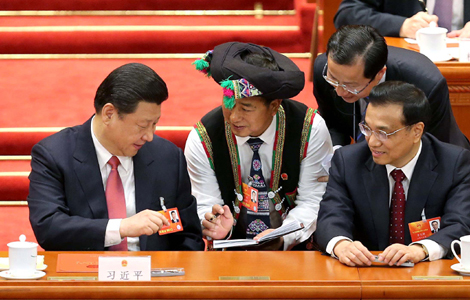2013 GDP growth target unchanged at 7.5%
Updated: 2013-03-05 09:02Lower inflation goal
The government has also decided to rein in inflation more decisively by lowering the control target for this year's consumer price index (CPI) increase to around 3.5 percent, compared with 4 percent targeted last year.
"China is still under considerable inflationary pressure this year and maintaining price stability has always been an important macroeconomic control target," Wen said.
Apart from upward pressure on the prices of land, labor, agricultural products and services, China is facing imported inflationary pressure resulting from quantitative easing policies in major developed countries, he noted.
The inflation control target is intended to leave room for adjusting the prices of energy and resources after taking into account the carry-over effect of consumer price rises in 2012, which will contribute about one percentage point to this year's inflation rate.
The government cooled the inflation rate to 2.6 percent year on year in 2012 from 5.4 percent in 2011. The rate eased further to 2 percent in January.
To achieve its targets, the government has vowed to maintain a proactive fiscal policy and a prudent monetary policy this year.
Higher local goals
Compared with the conservative forecast by the central government, almost all local governments except Shanghai were more aggressive in setting much higher GDP targets in advance.
Of all 31 provinces, autonomous regions and municipalities on the Chinese mainland, 11 local governments, mainly from central and western regions, aim to boost their local economies by 12 percent or above, while 13 local governments have set their growth targets at 10 percent.
The provincial government of southwest China's Guizhou Province is aiming for an ambitious growth rate of 14 to 16 percent.
"We still facing an arduous mission to develop, particularly for an underdeveloped region like Guizhou," said Long Changchun, chief of the province's Qianxinan prefecture.
The central government raised its official poverty line by 92 percent to 2,300 yuan in per capital annual income in rural areas in 2011, defining a number equivalent to the population of Japan as poor in China and creating pressure for local authorities to build the world's most populous nation into a relatively prosperous one by 2020.
The municipal government of Shanghai was the only local government to fix its GDP growth target at the same 7.5-percent level, while the provincial government of Guangdong, China's top economic powerhouse, further scaled down its 2013 growth target to 8 percent from 8.5 percent last year.
"The growth targets vary by region," explained Liu Shucheng, a political advisor from the Chinese Academy of Sciences.
"Governments in the relatively underdeveloped central and western regions are eager to catch up with their developed counterparts in eastern and coastal regions," Liu said.
The growth rate targeted by the central government has been widely interpreted as a minimum acceptable floor rather than a ceiling. The 7.8-percent growth seen in China's economy last year easily surpassed the goal the government set earlier in 2012.


